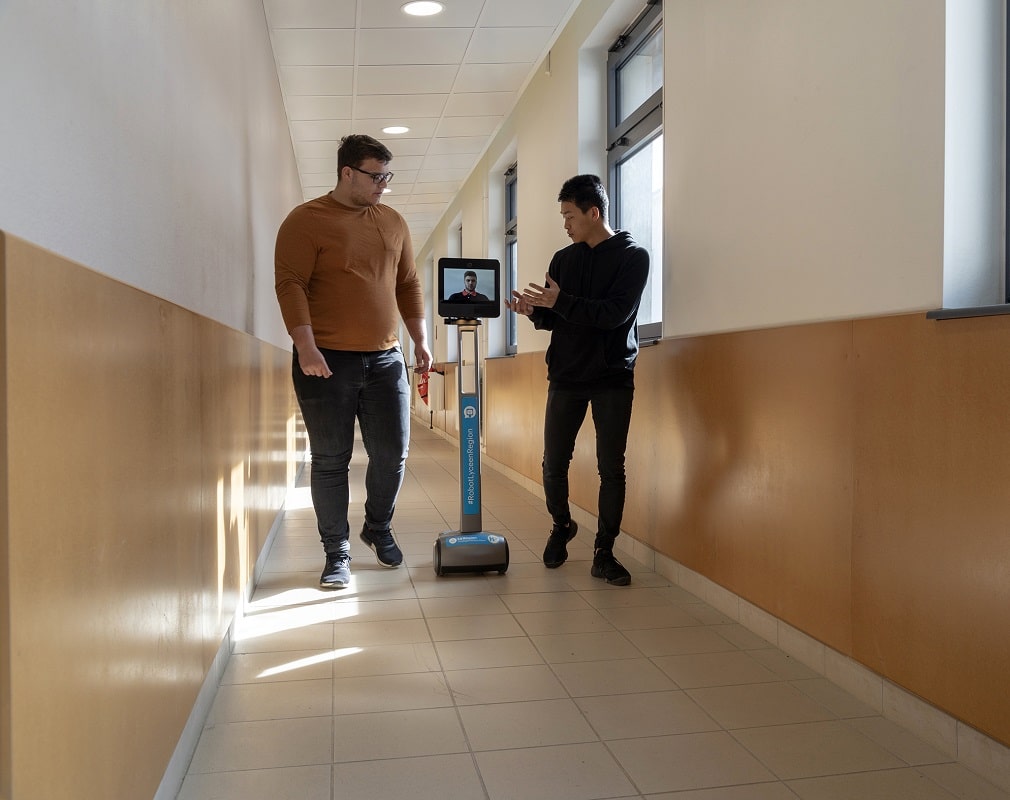Cantin Dumay, 22 years old, is in his second year of a Master’s degree in Strategic Management at the University of Paris-Saclay, in distance learning. In parallel to his studies, he has been working for the company Banijay for three years now, as an editorial assistant for a French television show. Suffering from a severe physical handicap, working on-site is impossible for him. Telepresence allows him to free himself from the constraints imposed by his physical condition: he explains how.
Overcoming disability in the workplace
Telepresence is by no means a robotic gadget for occasional use. If it is used for prestigious events such as the Ballon d’Or, the Césars or major sports events, it is also an indispensable tool in the daily life of people with disabilities. Cantin Dumay, a student and employee with a disability, shares his experience with telepresence.
Pioneer and leader in mobile telepresence, Awabot deploys Beam® robots, produced in France, throughout the world.
Whether for professional use or to promote the inclusion of disabled people, our experts will support you in all your projects.
Let’s talk now !

“My first experience with a Beam® robot was when I attended the Rentrée Solennelle at Université Paris-Saclay in January 2022, to which I was invited to receive an award as valedictorian. In January 2020, I was not able to participate in the same ceremony, despite the invitation I had received, because I was not aware of the existence of telepresence robots deployed as part of the TED-i program, and the organization of a classic videoconference was impossible.
I then started using my own robot at Banijay in February 2022, thanks in particular to the 70% financing granted to me by Agefiph, the French national association for the management of funds for the professional integration of disabled people.
Using a telepresence robot has considerably changed the way I interact with my colleagues and my approach to work. Indeed, the exchanges with my team members (at work as well as at the university) have been multiplied thanks to the robot. In a few weeks, it has allowed me to include myself much more than during the past two years.
Before the deployment of the telepresence robot at Banijay, I was already doing my information monitoring work, but it was much more difficult to interact to give my point of view. Now, I mainly use the robot to attend editorial meetings for the preparation of TV shows, and to exchange remarks and opinions.
Working in telepresence, a new horizon in terms of employability
“For my part, in terms of controlling the robot, I found the Beam® software very easy and fluid to use. From my computer, I control the Beam® telepresence robot with the mouse via the joystick of my electric wheelchair.
Moreover, the installation of the robot in Banijay’s offices was very simple and quick, thanks to the help of one of my colleagues who was willing and involved. At the beginning, some points were not very clear to the other employees. For example, I had to explain that when the screen doesn’t show my face, I can’t see or hear what’s going on in the premises.” Soon, as the system was used, all of Cantin’s colleagues became accustomed to seeing him move around the office and attend meetings via the telepresence robot.
Telepresence vs video conferencing: what are the advantages?
According to Cantin, Beam® telepresence robots have three major advantages over traditional videoconferencing tools such as Teams, Zoom, or Google Meet.
- First of all, the mobility of the device, “being able to position yourself wherever you want in the office without remaining static as you would with a computer” is a true asset for him.
- Then, in terms of audio quality, he noticed a clear difference between a meeting where he is connected in video conference and another where he is in telepresence via his robot: “the speakers of the Beam® robot are very powerful and allow me to broadcast the sound of my voice in the whole room”.
- Finally, the ability to “turn the robot on and off remotely and autonomously, without having to mobilize anyone in the office” is another major advantage for Cantin.
Telepresence at the university
Telepresence robotics is now an integral part of Cantin’s daily life, both in the professional and academic environments. Indeed, since September 2022, the University of Paris-Saclay has joined the TED-i program initiated by the French Ministries of National Education. With 4,000 robotic telepresence systems deployed, this measure enables pupils and students prevented from attending classes by serious and long-term somatic illnesses to benefit from telepresence solutions free of charge. In addition to ensuring educational continuity, TED-i allows students prevented by illness to maintain social ties with their teachers and classmates. “Thanks to the robot, I was able to meet and chat with other students from the very first class, which wasn’t really the case in other years,” says Cantin.
As Cantin’s testimony demonstrates, telepresence represents a real gateway to the world of work and employability for people with disabilities. At a time when many sectors of activity are struggling to recruit and are facing a shortage of talent, this is an opportunity to be seized by companies as well as by candidates who are prevented by disability, illness or distance. Telepresence can also allow an employee who is off work to return to work more serenely, as was the case for Baptiste, a member of the Awabot technical support team.
Telecommuting while having a real physical presence and the ability to move around the office is no longer fiction thanks to Beam® telepresence devices. If you have an inclusive telepresence project in your company, contact us!




